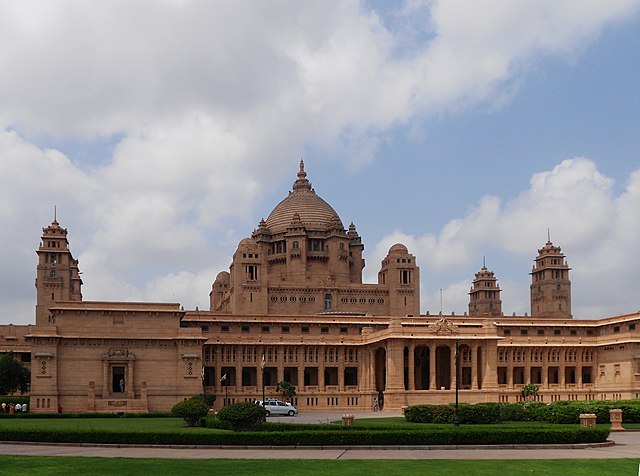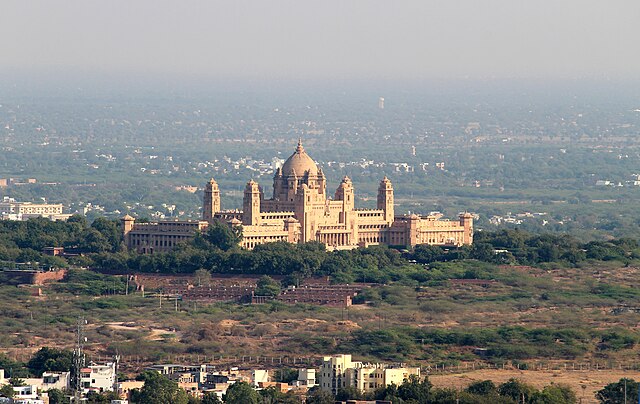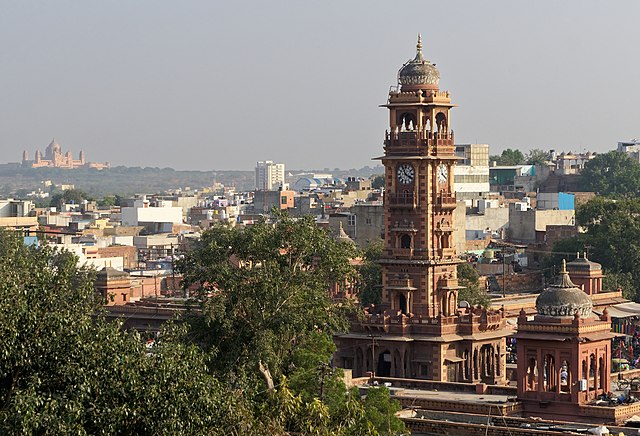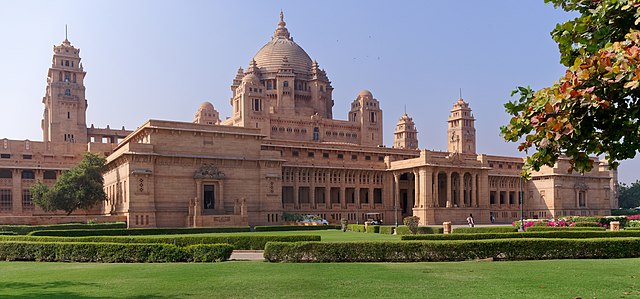Have you ever wondered what it feels like to step into a fairy tale? Welcome to Umaid Bhawan Palace in Jodhpur, where dreams meet reality in the most spectacular way possible. This isn’t just another tourist destination – it’s a living, breathing testament to India’s royal heritage that continues to enchant visitors from around the globe.
A Royal Introduction to Umaid Bhawan Palace
Perched majestically on Chittar Hill, Umaid Bhawan Palace stands as one of the world’s largest private residences and most magnificent palaces. This golden sandstone marvel isn’t just a monument frozen in time; it’s a vibrant blend of history, luxury, and royal living that offers three unique experiences under one magnificent roof.
What Makes This Palace So Special?
What sets Umaid Bhawan apart from other palaces? It’s the rare combination of being a luxury hotel, a captivating museum, and an active royal residence all at once. Imagine staying in a palace where real royalty still lives, where every corridor whispers tales of grandeur, and where modern luxury seamlessly blends with timeless elegance.
The palace boasts 347 rooms, making it one of the largest private residences in the world. But numbers don’t tell the whole story – it’s the soul of this place that truly captivates. From its Art Deco architecture to its stunning location overlooking the Blue City of Jodhpur, every aspect of Umaid Bhawan Palace speaks of unparalleled grandeur.
The Fascinating History Behind Umaid Bhawan Palace

Every great palace has a story, but Umaid Bhawan’s tale is particularly compelling. Built between 1928 and 1943, this architectural masterpiece emerged from a vision that was both ambitious and compassionate.
The Vision of Maharaja Umaid Singh
Maharaja Umaid Singh wasn’t just building a palace; he was creating a legacy. The forward-thinking ruler envisioned a structure that would showcase the best of both Indian and Western architectural styles while providing employment to thousands of people during challenging economic times.
The Maharaja’s vision extended beyond mere aesthetics. He wanted to create something that would stand the test of time, representing the progressive spirit of Rajasthan while honoring its rich traditions. This dual purpose – architectural brilliance and social responsibility – makes Umaid Bhawan Palace unique among Indian palaces.
Construction During the Great Depression
Here’s where the story gets really interesting. While the world was grappling with the Great Depression, Maharaja Umaid Singh made a remarkable decision. He employed over 3,000 people for the palace’s construction, providing crucial livelihood during one of history’s most challenging economic periods.
The construction wasn’t just about employment; it was about creating something extraordinary. The palace was built using the traditional technique of Chittar sandstone, with no steel or iron used in the structure. This not only ensured the building’s longevity but also kept the interiors cool during Rajasthan’s scorching summers.
Architectural Marvel Takes Shape
The construction process itself was a marvel of engineering and artistry. Master craftsmen worked alongside international architects to create something truly unprecedented. The palace’s foundation alone required 2.5 million cubic feet of marble and sandstone, setting the stage for what would become an architectural icon.
Architectural Brilliance: Art Deco Meets Indian Grandeur
Step inside Umaid Bhawan Palace, and you’ll immediately notice something extraordinary – the seamless fusion of Art Deco design with traditional Indian architecture. This unique blend creates an atmosphere that’s both exotic and familiar, grand yet welcoming.
The Unique Design Elements
The palace’s Art Deco influence is evident everywhere, from its geometric patterns to its streamlined forms. But what makes it truly special is how these Western elements have been adapted to suit Indian sensibilities and climate. The high ceilings, wide corridors, and strategic placement of windows create natural air circulation, making the palace comfortable even during Jodhpur’s intense summers.
The exterior showcases beautiful sandstone work with intricate carvings that tell stories of Rajasthani culture and history. The central dome, inspired by the Renaissance period, dominates the skyline and can be seen from miles away, serving as a beacon of royal splendor.
Interior Splendor and Royal Furnishings
Walking through the palace interiors is like taking a journey through time. The halls are adorned with priceless artifacts, vintage cars, and furniture that spans several centuries. The Throne Room, with its stunning frescoes and ornate decorations, gives visitors a glimpse into the opulent lifestyle of Indian royalty.
The palace’s interior design incorporates elements from various periods and cultures, creating a rich tapestry of artistic expression. From European chandeliers to Indian miniature paintings, every piece has been carefully selected to contribute to the overall grandeur while maintaining historical authenticity.
Three Experiences Under One Roof

What makes Umaid Bhawan Palace truly unique is its tri-fold identity. It’s not just one thing – it’s three extraordinary experiences combined into one magnificent destination.
The Luxury Hotel Experience
The hotel portion of Umaid Bhawan Palace, managed by Taj Hotels, offers guests the chance to live like royalty. With 64 rooms and suites, each designed to reflect the palace’s royal heritage while providing modern amenities, staying here is an experience unlike any other.
The rooms are spacious, elegantly furnished, and offer breathtaking views of either the palace gardens or the city of Jodhpur. The attention to detail is remarkable – from the hand-carved furniture to the marble bathrooms, every element speaks of luxury and refinement.
World-Class Amenities and Services
The hotel doesn’t just offer accommodation; it provides a complete royal experience. The spa treatments use traditional Indian techniques and ingredients, while the fitness center and swimming pool offer modern wellness facilities. The palace also features beautiful gardens, tennis courts, and even a museum that guests can explore.
Service at Umaid Bhawan Palace is legendary. The staff, many of whom come from families that have served the royal family for generations, provide personalized attention that makes every guest feel like royalty. From butler services to customized dining experiences, no detail is too small.
The Royal Museum Journey
The museum section of the palace offers visitors a fascinating glimpse into the lifestyle and history of the royal family. The exhibits include everything from vintage cars and clocks to hunting trophies and photographs that chronicle the palace’s history.
The museum displays are thoughtfully curated, telling the story of not just the palace but also the broader history of Jodhpur and Rajasthan. Visitors can see artifacts dating back several centuries, including weapons, textiles, and decorative items that showcase the region’s rich cultural heritage.
The Living Royal Residence
Perhaps the most intriguing aspect of Umaid Bhawan Palace is that it remains an active royal residence. The current Maharaja, Gaj Singh II, and his family still live in a portion of the palace, making it one of the few palaces in the world where visitors can experience authentic royal hospitality while royalty actually resides there.
This living heritage aspect adds an authenticity to the palace experience that’s hard to find elsewhere. The royal family’s continued presence ensures that traditions are maintained and that the palace remains a vibrant, living monument rather than just a museum piece.
Planning Your Visit to Umaid Bhawan Palace
Ready to experience this royal wonder? Let’s talk about the practical aspects of planning your visit to ensure you make the most of this extraordinary destination.
Best Time to Visit Jodhpur
Timing your visit to Umaid Bhawan Palace can significantly impact your experience. The best time to visit Jodhpur is during the winter months, from October to March, when the weather is pleasant and comfortable for exploring.
During these months, daytime temperatures range from 10°C to 24°C, perfect for palace tours and outdoor activities. The clear skies also provide excellent conditions for photography, allowing you to capture the palace’s beauty in all its glory.
Summer months (April to June) can be extremely hot, with temperatures soaring above 45°C. While the palace’s architecture keeps the interiors cool, outdoor exploration becomes challenging. Monsoon months (July to September) bring some relief from the heat but also occasional rainfall that might affect outdoor plans.
How to Reach the Palace
Getting to Umaid Bhawan Palace is relatively straightforward, with multiple transportation options available to suit different preferences and budgets.
Transportation Options
By air, Jodhpur Airport is the most convenient option, located just 5 kilometers from the palace. The airport connects Jodhpur to major Indian cities like Delhi, Mumbai, and Jaipur. From the airport, taxis and hotel transfers are readily available.
By train, Jodhpur Railway Station is well-connected to major cities across India. The palace is about 8 kilometers from the railway station, and taxi services are abundant. The train journey itself can be quite scenic, especially if you’re traveling from Delhi or Jaipur.
By road, Jodhpur is connected to major Rajasthani cities through well-maintained highways. The drive from Jaipur takes approximately 5-6 hours, while Delhi is about 7-8 hours away. Many visitors prefer this option as it allows them to explore other destinations along the way.
What to Expect During Your Palace Tour
Your visit to Umaid Bhawan Palace will be nothing short of magical, but knowing what to expect can help you prepare for this royal experience.
Museum Highlights and Royal Artifacts
The museum tour typically takes 1-2 hours and covers the most significant areas of the palace. You’ll see the magnificent Throne Room, with its stunning ceiling and royal furnishings, where official ceremonies and receptions still take place.
The vintage car collection is particularly impressive, featuring classic automobiles from the 1930s and 1940s that were used by the royal family. The clock collection showcases timepieces from around the world, each with its own unique story and craftsmanship.
The trophy room displays hunting memorabilia and photographs that provide insight into the royal lifestyle of the past. While hunting is no longer practiced, these exhibits offer a fascinating glimpse into historical royal traditions and the relationship between royalty and nature.
Photography Guidelines and Restrictions
Photography policies at Umaid Bhawan Palace are designed to protect both the artifacts and the privacy of the royal family. In the museum areas, photography is generally allowed in certain sections, but flash photography and tripods are prohibited to protect delicate artifacts.
The exterior of the palace and the gardens provide excellent photography opportunities. The golden hour, just before sunset, offers particularly stunning lighting that brings out the warm tones of the sandstone architecture. Many visitors find that the view from the palace gardens, looking out over Jodhpur, provides some of the best photo opportunities.
Interior photography in the hotel areas is usually permitted for guests, but it’s always best to check with the staff about specific restrictions. The royal residence areas are off-limits for photography to respect the privacy of the current royal family.
Staying at the Palace: A Royal Experience
If you’re considering staying at Umaid Bhawan Palace, you’re in for an experience that goes far beyond typical luxury accommodation. This is hospitality at its most refined and authentic.
Room Categories and Pricing
The palace offers various room categories, each designed to provide a unique experience while maintaining the highest standards of luxury. The Royal Suites are the most opulent, featuring separate living areas, marble bathrooms, and views of the palace gardens or the city of Jodhpur.
The Palace Rooms offer elegant accommodation with period furniture and modern amenities. These rooms typically feature high ceilings, large windows, and tasteful décor that reflects the palace’s royal heritage while ensuring contemporary comfort.
Pricing varies significantly based on the season, with peak winter months commanding premium rates. However, the experience of staying in one of the world’s most magnificent palaces is truly priceless. Many guests find that the memories and experiences justify the investment in this once-in-a-lifetime opportunity.
Dining Options and Culinary Delights
Dining at Umaid Bhawan Palace is an culinary journey that celebrates both local Rajasthani flavors and international cuisine. The restaurants within the palace offer everything from traditional thali meals to contemporary fusion dishes.
The Risala restaurant specializes in Indian cuisine, serving authentic Rajasthani dishes alongside favorites from other regions of India. The presentation is as impressive as the taste, with meals served on traditional silver thalis that add to the royal dining experience.
For those preferring international cuisine, the palace offers continental and Mediterranean options prepared by expert chefs using the finest ingredients. The wine selection is extensive, featuring both Indian and international vintages carefully chosen to complement the menu.
Private dining experiences can be arranged in various locations throughout the palace, including the gardens, terraces, and even the museum areas for special occasions. These personalized dining experiences allow guests to create unforgettable memories in truly spectacular settings.
Nearby Attractions Worth Exploring

While Umaid Bhawan Palace could easily occupy your entire visit to Jodhpur, the city offers several other attractions that complement the palace experience beautifully.
Mehrangarh Fort: The Mighty Citadel
No visit to Jodhpur is complete without exploring Mehrangarh Fort, one of India’s most magnificent fortresses. Located just a few kilometers from Umaid Bhawan Palace, this imposing structure offers breathtaking views of the Blue City below.
The fort’s museum houses an impressive collection of artifacts, including weapons, paintings, and decorative items that span several centuries. The intricate carvings and architectural details provide a fascinating contrast to the Art Deco style of Umaid Bhawan Palace.
The fort also offers unique experiences like zip-lining and cultural performances that add adventure and entertainment to your historical exploration. Many visitors find that combining visits to both Mehrangarh Fort and Umaid Bhawan Palace provides a comprehensive understanding of Jodhpur’s royal heritage.
Jaswant Thada: The Marble Memorial
Often called the “Taj Mahal of Marwar,” Jaswant Thada is a stunning marble memorial built in honor of Maharaja Jaswant Singh II. Located near Mehrangarh Fort, this architectural gem offers a peaceful contrast to the grandeur of the palace and fort.
The memorial’s intricate marble work and beautiful gardens provide excellent photography opportunities and a tranquil setting for reflection. The views from Jaswant Thada toward Umaid Bhawan Palace and the city below are particularly spectacular, especially during sunset.
Tips for Making the Most of Your Visit
To ensure your visit to Umaid Bhawan Palace exceeds your expectations, here are some insider tips that will help you navigate your royal experience like a pro.
Booking Strategies and Best Deals
If you’re planning to stay at the palace, booking well in advance is essential, especially during peak season (October to March). The palace has limited rooms, and demand is consistently high due to its reputation and unique offerings.
Consider booking directly through the palace or through Taj Hotels to ensure the best rates and service. Many packages include meals, spa treatments, and additional experiences that can provide better value than booking individual services separately.
For museum visits, purchasing tickets online can save time and ensure availability, particularly during festival seasons and holidays when visitor numbers increase significantly.
Cultural Etiquette and Dress Code
Respecting local customs and traditions enhances your experience and shows appreciation for the cultural significance of the palace. While there’s no strict dress code for museum visits, modest attire is recommended and appreciated.
For hotel guests, smart casual attire is appropriate for most dining venues, while some restaurants may require more formal dress during dinner service. The palace staff is always happy to provide guidance on appropriate attire for different areas and occasions.
Photography etiquette is important – always ask permission before photographing people, and be respectful of areas where photography is restricted. Remember that this is not just a tourist attraction but also a home and a place of cultural significance.
Conclusion
Umaid Bhawan Palace Jodhpur stands as a testament to royal vision, architectural brilliance, and timeless elegance. Whether you’re staying as a guest, exploring as a visitor, or simply admiring from afar, this magnificent palace offers an experience that transcends ordinary travel.
From its fascinating history born during the Great Depression to its current status as one of the world’s finest luxury hotels, Umaid Bhawan Palace continues to captivate hearts and minds. The unique combination of active royal residence, world-class hotel, and captivating museum creates an atmosphere that’s both authentic and extraordinary.
Your journey to this crown jewel of Rajasthan promises memories that will last a lifetime. In a world where authentic experiences are increasingly rare, Umaid Bhawan Palace offers something genuinely special – a chance to step into a living fairy tale where royal dreams become your reality.
Frequently Asked Questions
1. Can I visit Umaid Bhawan Palace without staying at the hotel?
Yes, absolutely! The museum portion of the palace is open to all visitors. You can purchase tickets for guided tours that cover the public areas, including the museum exhibits, throne room, and some of the magnificent halls. The tour typically lasts 1-2 hours and provides excellent insight into the palace’s history and royal artifacts.
2. What’s the difference between room categories at Umaid Bhawan Palace?
The palace offers several room categories including Palace Rooms, Royal Suites, and specialty suites. Palace Rooms are elegantly appointed with period furniture and modern amenities, while Royal Suites offer larger spaces with separate living areas and premium views. All rooms maintain the royal aesthetic while providing contemporary luxury and comfort.
3. Is photography allowed inside Umaid Bhawan Palace?
Photography policies vary by area. In the museum sections, photography is permitted in certain areas but flash photography and tripods are prohibited to protect artifacts. Hotel guests can typically photograph their rooms and public hotel areas. The exterior and gardens offer excellent photography opportunities. Always check with staff about current restrictions.
4. How far is Umaid Bhawan Palace from other major Jodhpur attractions?
The palace is conveniently located for exploring Jodhpur’s attractions. Mehrangarh Fort is approximately 6 kilometers away (15-20 minutes by car), while the old city and its markets are about 8 kilometers from the palace. Most major attractions in Jodhpur can be reached within 30 minutes from the palace.
5. What makes Umaid Bhawan Palace different from other heritage hotels in Rajasthan?
Umaid Bhawan Palace is unique because it functions as three entities: a luxury hotel, a museum, and an active royal residence where the current Maharaja still lives. This combination, along with its Art Deco architecture (rare in India), massive size (one of the world’s largest private residences), and the fact that it was built during the Great Depression as an employment project, sets it apart from other heritage properties.

